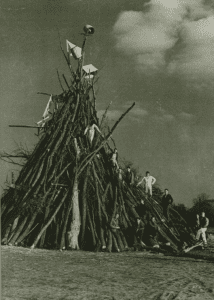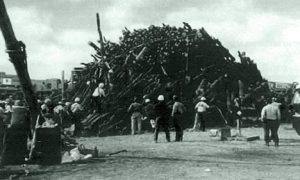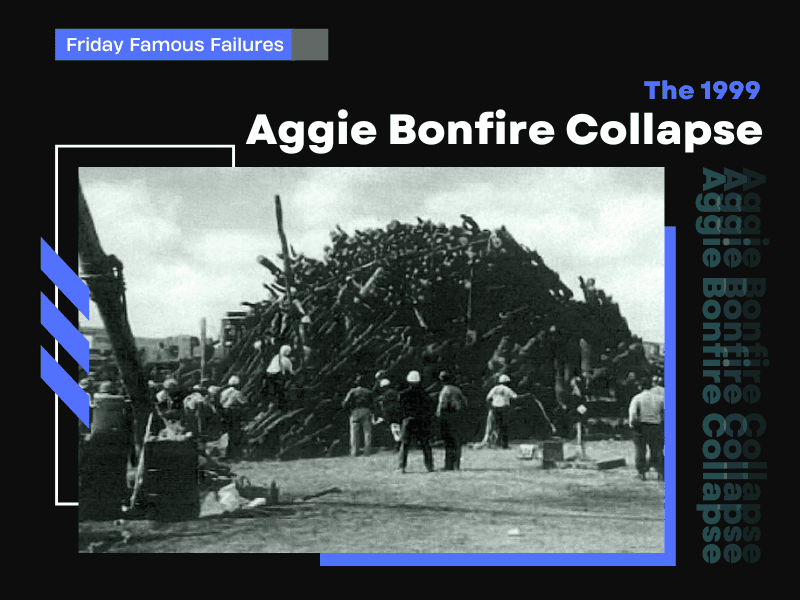On November 18, 1999, the traditional Aggie Bonfire, an iconic annual event at Texas A&M University, suffered a devastating structural failure that led to the death of twelve people, while injuring twenty-seven. The Aggie Bonfire was more than a mere bonfire; it was a towering structure of log stacks reaching nearly sixty feet high, an emblem of Aggie spirit and camaraderie. The collapse, which occurred during construction, was a shocking tragedy that deeply affected the University and the broader community.
The ensuing investigation, led by the U.S. Federal Emergency Management Agency (FEMA) and Texas A&M University, unveiled several engineering-related issues that contributed to the disaster.

Figure 1 – Aggies pose on the stack in 1939.
Let’s delve into the primary factors that led to the collapse and explore what professional engineers can learn from them.
The bonfire structure consisted of a tiered stack of logs, with the outer tiers acting as support for the inner tiers. One key finding was that the tiers were not aligned correctly, with the center poles of the upper tiers not placed directly above those in the lower tiers. This misalignment led to a non-uniform load distribution, causing the lower tiers to support excessive loads, which they weren’t designed to withstand.
Compounding the issue, the construction technique relied heavily on crude, manual methods, including wedging smaller logs to adjust for irregularities in the larger logs. This method, though it had sufficed in the past, proved inadequate in ensuring stability for a structure of such magnitude. It was a stark reminder that engineering principles cannot be bypassed, even when tradition dictates otherwise.
A lack of professional oversight was another major contributing factor. Unlike traditional construction projects, the bonfire was built largely by students, with little direct oversight from experienced engineers or professionals. While fostering spirit and camaraderie, this led to a scenario where safety and structural integrity were compromised.
These findings underline the importance of adherence to fundamental engineering principles. Foremost among these is the principle of proper load distribution. Engineering structures, whether they are buildings, bridges, or bonfires, need to be designed to evenly distribute loads to ensure stability and safety. Even slight deviations can lead to disastrous consequences, as the Aggie Bonfire collapse demonstrated.
The second key takeaway is the importance of professional oversight in any engineering endeavor. While enthusiasm and team spirit are commendable, they cannot replace the essential knowledge and experience that professional engineers bring to a project. Projects, regardless of their nature, should always involve professionals who can ensure safety standards are met and engineering principles are followed.
Finally, this tragedy highlighted the potential dangers of using informal, improvised construction techniques. Engineers rely on proven methods and processes to ensure the safety and reliability of their structures. When these are bypassed, the risk of failure increases dramatically.

Figure 2 – Rescuers search for survivors after the collapse
The Aggie Bonfire was a four-tiered log structure, designed to be set alight as a pre-game ceremony. Each tier consisted of vertically placed logs called “center poles,” and horizontally placed logs termed as “spokes.” The center poles of each tier formed the central core of the structure, while the spokes radiated outward, creating a stack resembling a wedding cake. Logs called “cribs” were stacked in the spaces between the spokes to fill in the structure.
The misalignment issue mentioned earlier resulted in an “eccentric” load, meaning that the center of gravity of the upper tiers did not align with the center poles of the lower tiers. This effectively placed more load on one side of the structure, creating a lateral force which the structure was not designed to resist. The situation was worsened by the inconsistent size and shape of the logs used, which resulted in uneven load distribution.
Furthermore, the 1999 stack was the highest in the history of the event, standing nearly 60 feet tall. This increase in height also resulted in an increase in weight and, consequently, the load on the lower logs, making the structure more susceptible to instability.
Fire safety was a significant concern, and, surprisingly, the issue was not that the structure was intended to be set alight. The investigation report found that the bonfire was designed to collapse inward when lit, which would help contain the fire. However, the tragedy occurred during construction, before any fire safety measures could be implemented.
FEMA’s report emphasized that the collapse was primarily due to a lack of adherence to fundamental engineering principles, rather than fire-related causes. The report found no fault with the bonfire’s intended burn methodology, which was designed to minimize the risk of an uncontrolled fire.
The FEMA report recommended a significant overhaul of the event’s safety procedures, advocating for professional engineering oversight and stricter adherence to safety regulations. It also suggested that future bonfire stacks should be built with the aid of modern engineering software, which can analyze load distribution and structural stability.
Thus, while the tragedy was not directly linked to fire safety, it underscored the importance of a comprehensive approach to safety in engineering projects. This includes not only the application of core engineering principles and professional oversight but also detailed contingency planning, such as fire safety measures.








Significantly, no professors looked up from their desks/laboratories to go to the School Administrators and point out the necessity of Engineering Department Oversight
You are entitled to your opinion but not entitled to be wrong on your facts, which destroys credibility on entire report. The largest bonfire was built by Class of ‘73 in 1969, majestic in its 103.73’ height.
I am a firm believer, that no matter how small the task there needs to be supervision and approval before anybody under me is allowed to perform the task themselves.
Students especially…. I believe no matter how intelligent you are there will always be a component of intelligence that deals with experience an equally as an engineer, you never stop learning.